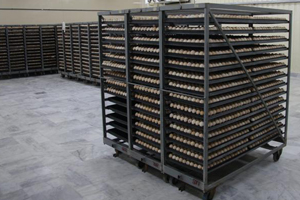“Spides” egg storage recovers hatchability

The best way to store hatching eggs between oviposition and the start of incubation, has often been studied. Ideally, all eggs should be set while still fresh, within a week of being laid.
If longer storage is unavoidable, then storage temperatures should be reduced, and any temperature fluctuations avoided. The advice is safe, and offers minimal opportunities for misunderstanding.
In contrast, when hens in nature lay and incubate their own eggs, the eggs laid first will be rewarmed every time the hen returns to the nest to lay another egg.
A series of experiments and field tests at Aviagen, looking at short periods of incubation during egg storage (Spides), have shown that it is possible to recover 60-70% of the hatchability lost when storage is unavoidable and has to be prolonged for more than a week.
For the best results, the eggs should be treated before hatch starts to fall, with repeat treatments every 6-7 days. While the heating speed and final temperature are both very forgiving, even cooling after treatment will help to maximise the impact. Warming the eggs too often, or for too long will limit the value of using Spides, and cumulative time above 32°C should not exceed 15 hours.
Incubator supplier Petersime is using this technology in their recently developed “BioStreamer Re-Store”. This incubator warms up the eggs for short periods of time during storage, restoring a significant part of the hatch decrease. An in-depth article on this technology will appear later this year in World Poultry.
Source: Lohmann Information, October 2013
Join 31,000+ subscribers
Subscribe to our newsletter to stay updated about all the need-to-know content in the poultry sector, three times a week. Beheer
Beheer











 WP Admin
WP Admin  Bewerk bericht
Bewerk bericht